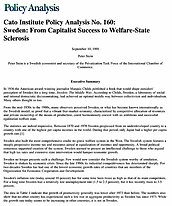From the mid-1930s to the 1980s, many observers perceived Sweden, or what has become known internationally as the Swedish model, as proof that a vibrant free-market economy, characterized by competitive allocation of resources and private ownership of the means of production, could harmoniously coexist with an ambitious and successful egalitarian welfare state.
The statistics are indeed impressive. Between 1870 and 1970 Sweden progressed from an underdeveloped country to a country with one of the highest per capita incomes in the world. During that period, only Japan had a higher per capita growth rate.[1]
Sweden also built the most comprehensive cradle-to-grave welfare system in the West. The Swedish system features a steeply progressive income tax and measures aimed at equalization of incomes and opportunity. A broad political consensus supported creation of the system. Sweden seemed to present an intellectual challenge to those who argued that high tax rates and extensive state intervention would hamper economic growth.
Sweden no longer presents such a challenge. Few would now consider the Swedish system worthy of emulation. Sweden is shaken by economic crisis. Since the late 1960s its industrial competitiveness has deteriorated sharply. For two decades Sweden has had one of the lowest economic growth rates of countries that are members of the Organization for Economic Cooperation and Development.
Sweden’s inflation rate (today around 10 percent) has for some time been twice as high as that of its main competitors. For a long time Sweden had a relatively low unemployment rate (1.5 to 2.5 percent), but it has recently risen to 3.5 percent.
The data in Table 1 indicate that growth of productivity generally was lower after 1973 than before. The numbers also show that no other country has experienced such a low rise in aggregate productivity as Sweden has since 1973. While the growth rate today seems to be increasing in other countries, it is not in Sweden.
The numbers in Table 2 indicate significant differences among selected countries during each time period. They also show that Sweden retained a top position until the 1970s when it dropped to the bottom position.
Figure 1 illustrates the differences in the growth rates of Sweden and other OECD nations.
The Swedish population seems to be aware that a change of course is necessary. The ruling Social Democratic Labor party (SAP), which has dominated Swedish politics since the 1930s and been the main builder of the welfare state, is in deep trouble. The SAP’s standing in the polls is between 30 and 33 percent, the worst recorded since opinion surveys began. Such results are indeed extremely low for a party that, from the late 1930s until the present, has always been able to get between 40 and 50 percent of the vote. The decline of the SAP can no longer be dismissed as a mid-term phenomenon. In the big cities, the party faces humiliation. In the last general election in September 1989, it secured 43.2 percent of the vote.
The beneficiaries of the Social Democrats’ misfortune are the nonsocialist parties, which may be able to form a government after the general elections in September 1991. The Moderate Coalition party (MSP), which is conservative, and the People’s party (FP), which is liberal and often called the Liberal party, are the core of the nonsocialist alliance. They have a joint economic platform that calls for privatization, deregulation, and moderate tax cuts. Those (albeit modest) steps could, if implemented, mark the beginning of a political watershed in Sweden.

